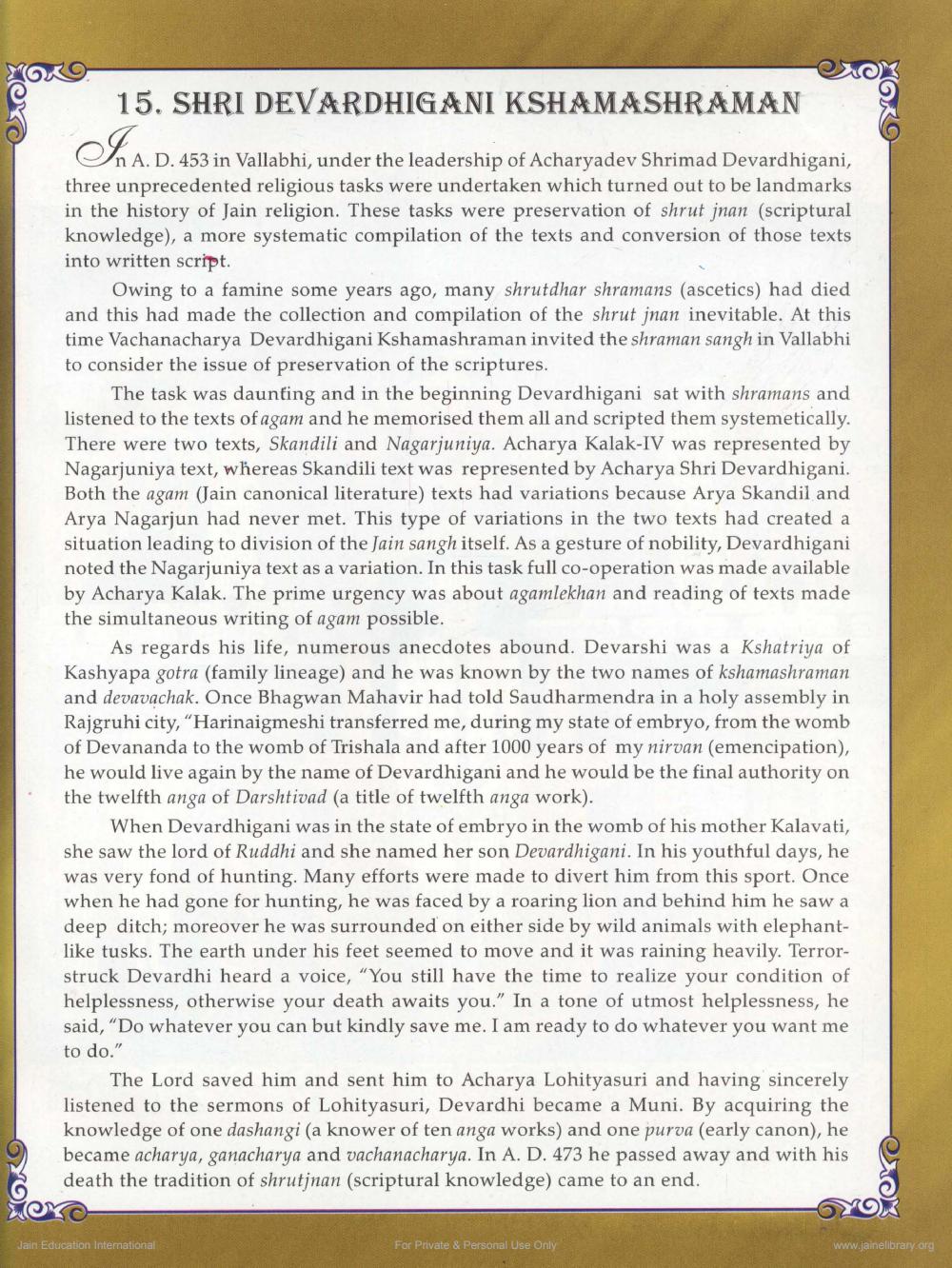________________
15. SHRI DEVARDHIGANI KSHAMASHRAMAN
nA. D. 453 in Vallabhi, under the leadership of Acharyadev Shrimad Devardhigani, three unprecedented religious tasks were undertaken which turned out to be landmarks in the history of Jain religion. These tasks were preservation of shrut jnan (scriptural knowledge), a more systematic compilation of the texts and conversion of those texts into written script.
Owing to a famine some years ago, many shrutdhar shramans (ascetics) had died and this had made the collection and compilation of the shrut jnan inevitable. At this time Vachanacharya Devardhigani Kshamashraman invited the shraman sangh in Vallabhi to consider the issue of preservation of the scriptures.
The task was daunting and in the beginning Devardhigani sat with shramans and listened to the texts of agam and he memorised them all and scripted them systemetically. There were two texts, Skandili and Nagarjuniya. Acharya Kalak-IV was represented by Nagarjuniya text, whereas Skandili text was represented by Acharya Shri Devardhigani. Both the agam (Jain canonical literature) texts had variations because Arya Skandil and Arya Nagarjun had never met. This type of variations in the two texts had created a situation leading to division of the Jain sangh itself. As a gesture of nobility, Devardhigani noted the Nagarjuniya text as a variation. In this task full co-operation was made available by Acharya Kalak. The prime urgency was about agamlekhan and reading of texts made the simultaneous writing of agam possible.
As regards his life, numerous anecdotes abound. Devarshi was a Kshatriya of Kashyapa gotra (family lineage) and he was known by the two names of kshamashraman and devavachak. Once Bhagwan Mahavir had told Saudharmendra in a holy assembly in Rajgruhi city, “Harinaigmeshi transferred me, during my state of embryo, from the womb of Devananda to the womb of Trishala and after 1000 years of my nirvan (emencipation), he would live again by the name of Devardhigani and he would be the final authority on the twelfth anga of Darshtivad (a title of twelfth anga work).
When Devardhigani was in the state of embryo in the womb of his mother Kalavati, she saw the lord of Ruddhi and she named her son Devardhigani. In his youthful days, he was very fond of hunting. Many efforts were made to divert him from this sport. Once when he had gone for hunting, he was faced by a roaring lion and behind him he saw a deep ditch; moreover he was surrounded on either side by wild animals with elephantlike tusks. The earth under his feet seemed to move and it was raining heavily. Terrorstruck Devardhi heard a voice, "You still have the time to realize your condition of helplessness, otherwise your death awaits you." In a tone of utmost helplessness, he said, "Do whatever you can but kindly save me. I am ready to do whatever you want me to do."
The Lord saved him and sent him to Acharya Lohityasuri and having sincerely listened to the sermons of Lohityasuri, Devardhi became a Muni. By acquiring the knowledge of one dashangi (a knower of ten anga works) and one purva (early canon), he became acharya, ganacharya and vachanacharya. In A. D. 473 he passed away and with his
death the tradition of shrutinan (scriptural knowledge) came to an end. Or
Jain Education Intemational
For Private & Personal Use Only
www.jainelibrary.org




